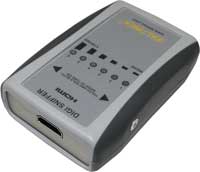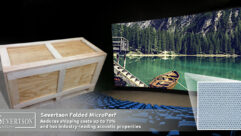

Altinex DIGI Sniffer Review
Mar 16, 2012 12:43 PM,
Reviewer: Patrick Barron
A valuable addition to the onsite toolkit.
Altinex has introduced a new product called the DIGI Sniffer. Designed to test the signal strength of digital signals, the DIGI Sniffer is compatible with HDMI, DVI, and Display Port signals regardless of the signal resolution and has a six-segment LED display. I was asked to test this unit in real-world situations at various jobsites to evaluate its capabilities.
When I received the package I first noticed the small size of the unit. It fit easily in one hand and was simple to carry around. It also came with batteries in the package, which meant it was immediately ready to use. I first attempted to use the tester without reading the directions to determine how difficult it would be to figure out and found I was able to use it with no prior knowledge. The instructions read, “Touch and hold both sides to turn on.” I did as instructed and a single LED came on, indicating that the tester was working but detecting a weak signal. Since the cable was not connected, finding a weak signal matched the indication on the LED display.
I took the tester to jobsites over the course of several weeks. At each site I found opportunities to test many different HDMI and DVI signals. I tested by connecting directly to the back of source devices like DVDs, cable boxes, and video extenders. I tested by unplugging the HDMI cable, going to the display and plugging it straight into the DIGI Sniffer. In each instance that I tested, I read a full strength six-LED signal. Never in any of the first round of testing did I get a LED reading anywhere between one LED and six LEDs. It was very accurate, though. If a signal was present, I got a full strength reading of six LEDs; if the signal was not there, I read just one LED. I measured between 60 and 80 separate video signals, and the tester was able to identify and measure a good versus bad signal each time without fail.
Concerned that the DIGI Sniffer was not operating properly, I called Altinex and talked to CEO Jack Gershfeld. He explained me that if a strong signal was present, then the full reading would be shown. Based on my experience at the jobsites while evaluating the DIGI Sniffer, I can conclude that each of the installations was done properly and the signal strength was good on each occasion. Gershfeld said I should expect to see degradation after roughly 10ft. to 20ft. of HDMI cable, which also depends on the cable quality. None of the sites I visited had a run of more than 20ft. that didn’t use an extender. Since the extender regenerates the video signal at the receiver, the signal strength would depend on the length of cable used from the extender to the display. Unfortunately this did not tell us if there was a valid signal passing from the UTP transmitter to the UTP receiver and if there was a problem with the UTP cables linking the extenders. It would only tell us if there was a good signal from the output of the extender through the HDMI cable to the tester. The inability to detect this limits the usefulness of the tester when used to test HDMI through extenders.
I asked about some features that were missing from the DIGI Sniffer: The ability to detect HDCP and an LCD readout of resolution and frequency. Gershfeld said these features will be available in a future Altinex digital signal product. For the list price of $145, the DIGI Sniffer performed the task of measuring digital signals extremely well. Most other digital video testers on the market are much more expensive, which means that often a company can only afford one tester if they are able to afford one at all. At this price, a company can afford to buy one for every installation crew and it should be an essential part of every installer’s toolkit. Personally, I will be getting one to accompany me to every jobsite I go to in the future.
SUMMARY
Pros: Small, affordable, accurate.
Cons: Limited ability to test valid signal when using UTP extenders; can’t detect HDCP; doesn’t have an LED readout of resolution and frequency.
Price: $145
SPECIFICATIONS
Size: 1.1”x2.5”x3.7” (HxWxL)
Weight: 5oz.
Power: 2 AA batteries










